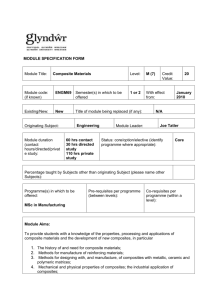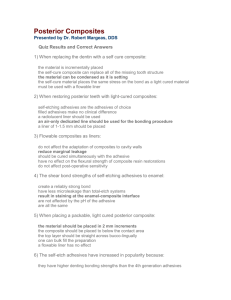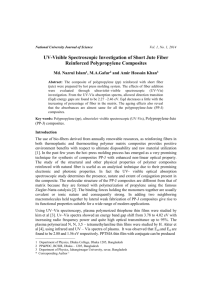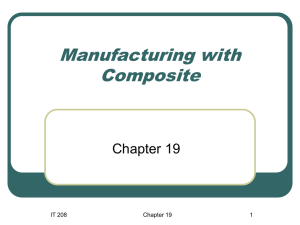INTERIOR WALL FINISHES ppt Kagz
advertisement
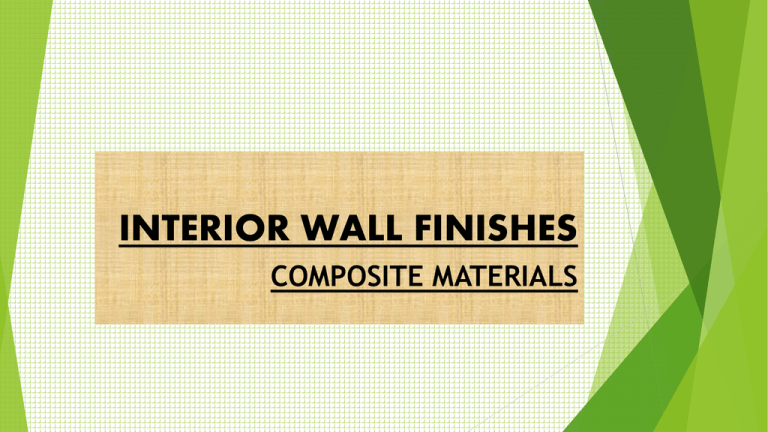
INTERIOR WALL FINISHES COMPOSITE MATERIALS What are composites? Composites are engineered products made from two or more different materials. Its any product or construction made up of a number of different materials or technologies; usually a laminated material or one of plastic, concrete or cement reinforced with fibres of glass, mineral, metals or polymers. Where are composites found? Composites are used to raise performance levels, address traditional material design limitations, and enable the development of new product solutions. Composites are also used in many critical industrial, infrastructure, aerospace military and Architectural applications. What are composites made from? The term composite can describe many types of engineered materials, but the most common engineered composite materials are fiber reinforced polymers (FRP). The reinforcing fiber is commonly glass fiber, although high strength aramids, plant based fibers and carbon fibers are used in some applications 1.Acoustical Panels: Large overhead composite panels and wall mounted curved reflectors dramatically improve acoustics and listening quality in auditoriums, lecture halls, churches, performance halls and rehearsal spaces. 2.Wall Cladding Fiberglass Reinforced Plastic (FRP) composite wall are used throughout the construction and building materials industries. FRP offers a number of significant features including resistance to mold, mildew, and bacteria growth, high impact strength, high moisture resistance, chemical resistance, stain resistance, sanitary finish, low maintenance, and easy installation. 3.Composite Flooring Polished composite surfaces provide stunning appearance in flooring applications and are extremely durable. 4.Divider Panels Composite panels provide decorative and functional space separation and can be used to produce stunning light effects. Reinforced composite panels are extremely strong yet can offer a delicate and attractive appearance. 5.Solid Surface Shower Solid surface showers allow specific designs and unique spaces to be created with easy to maintain surface with an array of color and pattern options. These surfaces are non-porous and can be easily renewed. 6.Urinals. The use of composite urinals yields a lighter weight but more durable unit than vitreous china. Composite units also resist the crack and break issues common during shipping and installation of urinals 7.Robal Glass Surfaces Composites offers an endless array of customized sizes for shower bases, wall panels and vanity tops. The composite is manufactured with a surface coating to ensure surface integrity and to resist stains, water, heat, chemicals, bacteria and everyday wear and tear. 8. Sun Screens Composites provide a durable and maintenance free method of providing your interior and exterior areas with shading and screening. Screens and shades allow building occupants outdoor views while minimizing glare inside your living and work space. 9. Skylights Skylights are an effective means of adding natural daylight while maintaining structural integrity 10. Bath surfaces Bath environments, specifically suited for showers, tubs and sink counters. Also found in reception and decorative surfacing locations. 11. Doors The use of composites opens new doors for builders and home-owners interested in long term performance and low maintenance. • Low cost design flexibility • High impact resistance • Doesn’t rot, rust, corrode, or swell • Provides thermal and acoustical insulation 12. Curtain walls Fiberglass pressure plates provide improved thermal properties over aluminum pressure plates for curtain walls frames of commercial buildings. Advantages • Low thermal bridging • Design flexibility • Strength and durability • Fewer installation steps • Customize projects with face covers of various depths and profiles The benefits of using composite materials include: •High strength •Lightweight •Corrosion Resistance. •Durability •Design Flexibility •Parts Consolidation •Dimensional Stability: FRP composites maintain their shape and functionality even under severe mechanical and environmental stresses. •High Dielectric Strength: FRP composites have excellent electrical insulating properties •Low Thermal Conductivity: FRP composites are naturally poor conductors •Elevated Temperature Service Composites and sustainability Many of the properties that make FRP composites the preferred material of choice for performance reasons also result in a more sustainable material. These properties include: •Durability, requiring less frequent maintenance and replacement •Resistance to rot and corrosion, resulting in a longer service life •Insulating property, providing energy savings during use •Composites can contribute to reducing environmental impact by direct application and through functional applications. •Direct contribution can be seen in applications that reduce energy requirements, such as: Fiberglass window lineals and doors do not rot, rust or swell – resulting in fewer air leaks and better seals than wood and steel products. THANK YOU KAGIRI STEPHEN NJENGA BO2/0902/2012
